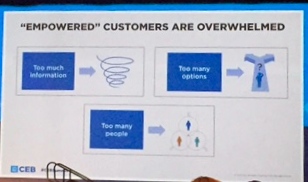I’m a “binger.” I’m “all in” when it comes to consuming content and I’m not alone. Netflix reports that of it’s 40 million US subscribers, over 60% report b eing “binge watchers.” We also know that our personal habits influence our professional habits, so could there be a group of “binge buyers” who are currently being underserved with our content efforts, and could that be hurting our sales efforts?
eing “binge watchers.” We also know that our personal habits influence our professional habits, so could there be a group of “binge buyers” who are currently being underserved with our content efforts, and could that be hurting our sales efforts?
For example, I’m working with a client to help them “digitalize” the organization. As part of the effort, I’m evaluating software tools to help improve the performance of their content marketing efforts. So I’ve been binging on vendor content, going deep into their sites and watching hours of video to evaluate their fit for our client’s needs. However, one of the vendor’s limited the information on their site forcing me to request a demo to learn more about their tool.
Ten days after I requested the demo the vendor finally reached out to me. It then took another 3 days to align our schedules. The day of the “demo” was disappointing. I didn’t get to see the tool, but instead I got a 10 page powerpoint pitch. Running out of time that day forced me to set up yet another call more than a week away. Needless to say, they didn’t make the short list of vendors to consider.
Here’s the point we know from CEB, Sirius Decision, and Forrester decision makers are more than half the way through the buying process before they engage a sales person. If you are an organization that is trying to insert a sales person in upstream, you run the risk of slowing the buying process and/or being eliminated from it.Your prospects maybe “bingers” like me. Let them go deep and gather all of the information they need on their own. It will accelerate your sales cycles, increase lead volume, and lower the cost to sell. I know it will set off alarms with your lead tracking process, but the fact is, buyers control the process and they will let you know when they need to talk to someone.
Still skeptical? Atlassian, an open source provider of project management and app software sold over $300 million in enterprise software without a single sales person. The keys to their success: a great product, word of mouth and letting buyers sell themselves. “Customers don’t want to call a salesperson if they don’t have to,” says Scott Farquhar, Atlassian’s co-chief executive officer.
“They much rather be able to find the answers on the website.”
Don’t get me wrong. I believe sales people can serve a very valuable role for the buyer, and for organizations. But that role has shifted, instead of being the product “spokes person” they should now focus on better understanding what information buyers need to drive a consensus on a decision within their organization.
Unsatisfied with my first call with the rep that left me without seeing the tool, I found a product demo video on Vimeo. I doubt they even knew it existed, so by second call, I was already well versed on the tool. I knew how it differed from the other tools being evaluated, but what I didn’t know was why my client would need that functionality. That is where the sales person could have been helpful, and could of earned themselves a shot at the sale. The lesson; bingers are out there and growing, if you throttle bandwidth on content you could be limiting, or in this case, eliminating opportunity.

 and the involvement of other decision makers in the process, according to
and the involvement of other decision makers in the process, according to